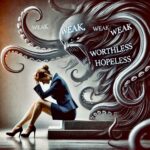Straddling the literature and eating disorder divide
So much we don't know; so much we can learn

Straddling the literature and eating disorder divide
It’s funny when we realise that we have feet in two worlds that barely speak to each other. I have one foot in the world of eating disorder (ED) research and treatment and the other in the world of literary studies. The literary people tend to assume that books must be a good thing, and even those who (like me) put their theories to the test don’t often seem to have the thought that they could ever actually do harm. And then the ED people tend to assume that something as nebulous as reading could never have much effect at all on something as seriously physical as an ED.
Of course, I’m not the only person straddling the divide. There are therapists who invite their clients to read and write stories or poems as part of their recovery. There are practitioners who run reading groups in healthcare contexts, and researchers who run studies on those groups and also on individual reading. There are people like June Alexander, who offer guidance in how to write one’s life story to learn from it, and perhaps even help others.
The single characteristic that I’ve come to value most highly, among all these groups of individuals with one or more toes in these contrasting worlds of research and practice, is the readiness to say, “I don’t know”. This morning, I read a New York Times piece that shared a lovely perspective on the unending excitement of being acceptant about our ignorance:
Michael Smithson, a social scientist at Australian National University who co-taught an online course on ignorance this summer, uses this analogy: The larger the island of knowledge grows, the longer the shoreline — where knowledge meets ignorance — extends. The more we know, the more we can ask. Questions don’t give way to answers so much as the two proliferate together. Answers breed questions. Curiosity isn’t merely a static disposition but rather a passion of the mind that is ceaselessly earned and nurtured.
You can’t expand your island of knowledge unless you’re willing to say you don’t know, and as soon as you expand it a bit, you’ll become aware of exhilarating new areas of previously un-guessed-at shore. One major moment for me of glimpsing a new curve of coastline was when I finished writing a book that had accidentally turned into a memoir about my experience of anorexia and recovery. I realised that although I’d thrown all my creativity into making this a book that would do good rather than harm, I simply did not know whether I had succeeded. And I needed to find out.
I’d known how hard I needed to try to make this book do something different from the norm because of a prior research project (Troscianko, 2018) that had shown how often reading ED-themed narratives is perceived by individuals with an ED to have seriously unhelpful effects. I’d been suspicious of the ED recovery memoir genre partly for that reason—and also because their format is so often a long chronicle of the miseries of living with an ED followed by an implausible “happily ever after thanks to therapy” coda.
I’d intended to write a much less narrative style of text—and I eventually found an alternative to the traditional narrative by writing most of the book in dialogue form, letting the anorexic perspective be voiced but never stand unchallenged. I also made the whole book about either contemplating recovery or doing it—processes that seem far more interesting and much more urgently in need of exploration than the processes involved in falling and staying ill.
I had also, instinctively, followed a lesson that June Alexander recently told me she’s gleaned from decades of working with EDs and narratives:
“Waiting until one’s healthy self is restored (the more fully, the better) is vital when writing a recovery memoir. Otherwise, the ED ‘voice’ will likely embed itself in the text’s messaging. The risk is that the writing will come from the ED self and not the healthy self of the writer.”
June suggests that it’s best for a writer to wait several years after refinding their healthy self, so that they can “draw on their experience (e.g., from diary documentation) while a participant ‘in’ the illness, and also look upon their experience as an observer (from outside the illness)”.
I had not only the original records from diaries and emails and letters to draw on, but also all the meta-documentation from my Psychology Today blog—begun in the late stages of my own recovery, in 2009, and maintained ever since. The blog has grown steadily less autobiographical over the years, but as I wrote this book I drew on the storytelling and the wider insights alike, to try to make it as good and useful as it could be.
But still, there was this profound not-knowing. And because I have a long-trained strand of empirical researcher in me, I decided that I needed to carry out an experiment. What would it be designed to find out? Well, in general, how readers responded to the book, but more pointedly to answer the question, “Should it be published?” I knew from the outset that if I was going to go to all the effort (and time, and expense) of running an experiment, there would need to be real stakes. And there’s nothing much more real, in writerly terms, than asking “to publish or not to publish?”.
Carrying out the experiment was indeed difficult. (June kindly helped with recruitment via this blog!) Designing it was even harder. Who should take part? What precisely should participants be asked to do? What should we be measuring? What should the control condition be? Eventually these questions gave way to answers, and my colleagues James Carney and Rocío Riestra-Camacho and I committed ourselves to a thorough and workable experiment.
The recruitment of 64 individuals to read either my book, The Hungry Anorexic, or a book about Zen meditation called Ten Zen Questions (by my mother Sue Blackmore), took over a year. The data analysis took a good few months, and getting everything written up for publication in the Journal of Eating Disorders (Troscianko, Carney, & Riestra-Camacho, 2024) took what felt like aeons, too.
But the book passed the test, and so it was published as The Very Hungry Anorexic this summer. Interestingly, not only did it do no measurable harm on either of the standard clinical measures we used, but both it and the book about meditation seemed to do considerable good—especially on the “stages of change” measure, which taps into attitudes towards illness and recovery. These results expand that coastline further, making us wonder what characteristics these two books might have in common that would lead them to generate comparably positive responses—or what aspects of the experimental setup might have had such effects irrespective of the book being read.
We’ll have to wait for future experiments, whether run by me or by others, for these questions to be answered and, in turn, throw up their own new questions. In the meantime, this particular book about recovery comes robustly ethics-tested—which means that we did our best to make sure that the chances of you reading it and finding it shockingly unhelpful are minimal! But of course, it’s all context-dependent.
Another thing June has learned and that came up often in our original survey study (and has recurred in other findings since) is that the text is what it is, but the reader will determine a huge proportion of what she makes of it. As June wrote to me,
Depending on the state of illness/recovery the reader is in when reading the memoir, their interpretation of the same text can differ greatly. The difference in interpreting the same words can be black and white; positive and negative-–sigh, because the ED is a master at misinterpretation. […] If the reader is in the phase where the ED is dominating, their eyes will be drawn to any snippets in the text that offer new ways to strengthen their illness
A respondent in our 2018 survey study put it almost the same way:
ED books have brought both comfort and destruction to my thought processing, depending on whether or not I am healthy. However, when I am ill, I can twist the words of ANY book into a message to support my disorder. For me, it is not the genre, as much as it is the state of mind of the reader.
There’s danger in this great malleability of words by minds. But as June says, there’s also great positive potential:
When reading a memoir, the greatest benefit is likely to occur when the reader wants to recover their healthy self, or when they are reading with a mentor or coach who can suggest a healthy-self interpretation for consideration. When the reader wants to recover, their eyes will be drawn to text messaging that offers encouragement, solutions, hope and inspiration…
Fellow PT blogger Alli Spotts-De Lazzer has written a little about how to choose the books we read wisely. Once we’ve chosen, we must then make of them what we can, giving credence to the life-desiring parts of ourselves and savouring one thing books are brilliant at giving us: the expansion of the boundary between knowledge and what is not yet known.
REFERENCES





